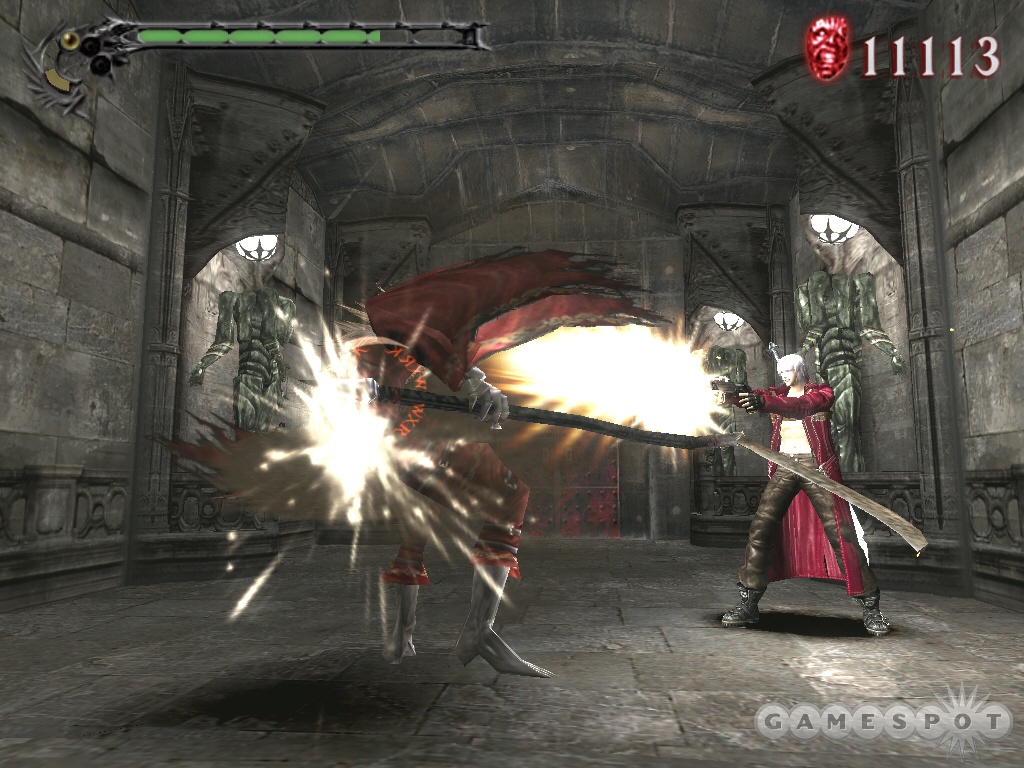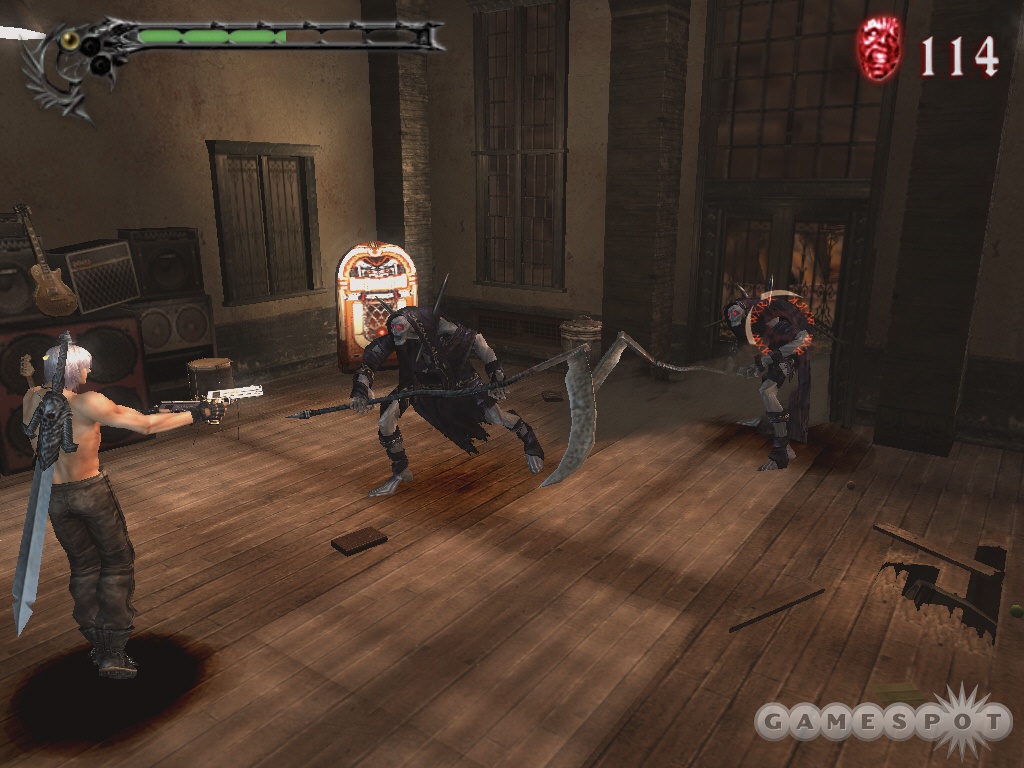Released earlier this year for the PlayStation 2, Devil May Cry 3: Dante's Awakening - Special Edition was a budget-priced, updated version of one of last year's toughest, best, most intense action adventure games on consoles. Between its manic hack-and-slash gameplay and its over-the-top anime-inspired presentation, the game never seemed like it would make a good fit on the PC. But a PC version came along anyway, offering up a no-frills port that loses some of its charm and quality in translation, yet retains some solid action and a lot of personality underneath it all. So the underlying game is still great, but unless you categorically can't play this game on a PS2 yet feel compelled to play it anyway, this version isn't your best bet.

This update rebalances the original game's notoriously hard difficulty setting while adding a new playable character (as an unlockable bonus) and some new battles. What made Devil May Cry 3 such a great game in the first place was its flashy presentation and its fantastic combat. As the brash demon hunter Dante, you can kick all kinds of otherworldly ass top to bottom, courtesy of your various over-the-top firearms and melee weapons. Split-second timing is necessary to avoid your enemies' ferocious counterattacks, and learning to dodge properly and to not get blindsided by an occasionally awkward camera angle definitely takes time. But eventually, everything feels just right, and suddenly you're making mincemeat out of tons of foes--pulling off spectacular combos involving multiple weapons, thrashing foes up into the air, high in the sky, and down to the ground, and then finishing them off while they're lying helpless at your feet. It gets all the more intense when you're battling the game's numerous boss opponents, which are arguably the highlight of the experience. Occasional puzzle-solving and backtracking offer a brief respite from the carnage, but otherwise they aren't particularly exciting aspects of play. A few basic role-playing elements are effectively integrated, allowing you to choose between some different fighting styles and learn upgraded moves and abilities for those styles the more you use them.
One of the distinguishing features of the PlayStation 2 original is how fast it moves. The smooth frame rate wasn't just for show, because many of the game's demonic foes strike quickly and hit hard, so you needed fast reflexes to get out of the way before they skewered you. On the PC, the visuals don't hold up as well, even if you have a very fast system and run the game at a relatively low resolution. Some of the cinematic cutscenes also look pretty bad here, thanks to grainy-looking video playback. It's not immediately clear why this version doesn't move as well as its PS2 counterpart, considering that these simple, somewhat drab 3D graphics look pretty unflattering by the PC's high standards. At least there's some great visual design on display to make up for the dated presentation, and the motion-captured cutscenes that make up Devil May Cry 3's ridiculous but engaging story are still excellent.

On top of the graphical deficiencies, the PC version of this game is virtually unplayable using the default keyboard controls. For whatever reason, no attempt was made to come up with a mouse-and-keyboard control scheme, which might have been serviceable. So you'll need a decent gamepad to get anywhere, like the Microsoft Xbox 360 controller we used for most of our testing; unfortunately the game forced us to use the right analog stick, not the left analog stick, for moving around, causing us to cramp up on the controller. Using a Logitech gamepad, we could at least move around using the D pad, while the left analog stick defaulted to switching between different option screens. The game lets you remap the button functions on your gamepad, but not the sticks. Other than these types of issues, the game is essentially identical to the PS2 version. This means that if you can find a comfortable control scheme and visual settings that get the game to run smoothly on your rig, you'll find in Devil May Cry 3 a blazingly fast and intense experience that's very much unlike other action games for the PC.
This isn't natively a PC game, so don't expect PC-style amenities, such as being able to save your progress at any time. In fact, in the original version of the game, you needed to purchase yellow orbs to continue from a nearby checkpoint when you died. These orbs were prohibitively expensive in the beginning, and the system itself was fairly confusing anyway, so there was a very steep learning curve that revolved around forcing you to replay entire levels only to get beaten over and over again by tough boss monsters waiting for you at the end. The Special Edition's optional new continue system is far more lenient, since it lets you continue from a nearby checkpoint as often as you wish, and if you have a gold orb in your inventory, you can bring yourself back to life right where you died. Having two (or more) lives with which to beat the game's bosses makes all the difference in the world, and it goes a long way toward making the legendary difficulty level of Devil May Cry 3 a lot less remarkable, for better or for worse. You've still got the old continue system to use if you want it, but most players will naturally take the path of least resistance. Ironically, even this much more lenient continue system will still likely seem inconvenient to those accustomed to PC games letting you save anytime, anywhere.
You can't play as Dante's brother Vergil right off the bat, but you'll learn to respect him as you play through the game for the first time. He has deadly fencing skills and lightning-fast moves, and you'll find that all of his attacks are at your disposal when you play as him. His quick-draw attacks with his Japanese battle sword can devastate multiple enemies at once, and instead of guns, he can summon limitless mystical swords that fly out and pierce his foes. Later, he can upgrade these weapons to form defensive barriers and more. In fact, he's considerably stronger than Dante, at least at first. He has access to three useful melee weapons right from the start, and he also starts out with the devil trigger ability, which grants him temporary invincibility and health regeneration--truly a lifesaving skill that Dante doesn't learn until a good way into the story. But is stronger really better in this case? Vergil just isn't as fleshed out as Dante from a gameplay standpoint. He starts with all his weapons and has only the one "dark slayer" fighting style, which is like Dante's trickster style, only cooler sounding. You can still unlock some new fighting abilities as you go, but you don't feel as though you're growing stronger and stronger like you do with Dante. What's more, there's no story continuity when playing from Vergil's perspective. His inclusion in the game makes for a good bonus, but Dante is still the star of the show.

There are a few other added extras. The Bloody Palace is a pretty good bonus that's functionally equivalent to a survival mode. This mode strips away all semblance of plot--instead focusing purely on DMC3's exciting combat system--as it throws you into one battle after another. The Bloody Palace consists of 9,999 levels, but after each fight, you can choose to advance by one, 10, or 100 levels by entering one of three elemental portals. Health power-ups can keep you alive over the long haul, but occasional run-ins with DMC3's bosses might just end your Bloody Palace run prematurely. You can't save your progress in this mode, and it pits you against lots of familiar foes, so it's mostly best suited for hardcore players looking to hone their skills and squeeze as much out of the game as they can. For good measure, you also have the option to enable a "turbo mode," which speeds up the gameplay by 20 percent--enough to make the action maybe a little more manic than usual, though it might hurt your frame rate even more. You can also watch the game's fantastically choreographed cinematic cutscenes in a theater mode, as well as unlock gallery images and multiple costumes for both characters.
It's plainly apparent from playing this game that it wasn't originally designed with the PC platform in mind, but that doesn't make it bad. This version of Devil May Cry 3 doesn't play quite as well as the original, yet it still offers an intense and challenging experience so long as you're open to a stiff challenge, have a gamepad, and are willing to put up with a bunch of holdovers from this game's console roots.

You can't play as Dante's brother Vergil right off the bat, but you'll learn to respect him as you play through the game for the first time. He has deadly fencing skills and lightning-fast moves, and you'll find that all of his attacks are at your disposal when you play as him. His quick-draw attacks with his Japanese battle sword can devastate multiple enemies at once, and instead of guns, he can summon limitless mystical swords that fly out and pierce his foes. Later, he can upgrade these weapons to form defensive barriers and more. In fact, he's considerably stronger than Dante, at least at first. He has access to three useful melee weapons right from the start, and he also starts out with the devil trigger ability, which grants him temporary invincibility and health regeneration--truly a lifesaving skill that Dante doesn't learn until a good way into the story. But is stronger really better in this case? Vergil just isn't as fleshed out as Dante from a gameplay standpoint. He starts with all his weapons and has only the one "dark slayer" fighting style, which is like Dante's trickster style, only cooler sounding. You can still unlock some new fighting abilities as you go, but you don't feel as though you're growing stronger and stronger like you do with Dante. What's more, there's no story continuity when playing from Vergil's perspective. His inclusion in the game makes for a good bonus, but Dante is still the star of the show.
There are a few other added extras. The Bloody Palace is a pretty good bonus that's functionally equivalent to a survival mode. This mode strips away all semblance of plot--instead focusing purely on DMC3's exciting combat system--as it throws you into one battle after another. The Bloody Palace consists of 9,999 levels, but after each fight, you can choose to advance by one, 10, or 100 levels by entering one of three elemental portals. Health power-ups can keep you alive over the long haul, but occasional run-ins with DMC3's bosses might just end your Bloody Palace run prematurely. You can't save your progress in this mode, and it pits you against lots of familiar foes, so it's mostly best suited for hardcore players looking to hone their skills and squeeze as much out of the game as they can. For good measure, you also have the option to enable a "turbo mode," which speeds up the gameplay by 20 percent--enough to make the action maybe a little more manic than usual, though it might hurt your frame rate even more. You can also watch the game's fantastically choreographed cinematic cutscenes in a theater mode, as well as unlock gallery images and multiple costumes for both characters.
It's plainly apparent from playing this game that it wasn't originally designed with the PC platform in mind, but that doesn't make it bad. This version of Devil May Cry 3 doesn't play quite as well as the original, yet it still offers an intense and challenging experience so long as you're open to a stiff challenge, have a gamepad, and are willing to put up with a bunch of holdovers from this game's console roots.